 By Hubery Editer
By Hubery Editer
Preview
Drying technology application has a long history in China since the paper-making technology was born. And the dryer machine has been used for hundreds of years. Fixed bed dryer machine is the earliest ancestor of modern drying equipment. The tunnel-structured dryer is the first used modern dryer in the middle 19th century, which is a sign of dryer machine development from intermittent operation to continuous operation. The invention of the rotary dryer is another force that makes the drying technology grow with one big step. Rotary dryer realizes a better particle material agitation to improve the drying capacity and efficiency. With the development of science, technology and innovation, rotary dryer is transformed for more professional application in various fields. For example, there is ore powder dryer machine used in ore dressing plants, sawdust dryer used in heating, gardening and other fields, kaolin dryer used in the chemical industry, ceramic industry, refractory industry, etc. and sand dryer used in the construction industry and building material.
Industrial rotary dryer has a wide range of applications and can be used for drying more than 100 kinds of materials in many industries. Different types of dryers can be applied in different fields. For example, a single-cylinder indirect heat transfer dryer can be used to dry some chemical raw materials and easily-polluted materials; a three-drum dryer is more suitable for drying ore powder and yellow sand, etc.; a net belt dryer is suitable for coal block, vegetable and food drying; and a vertical dryer is mainly used for briquette coal drying in coal industry. Among different dryers, rotary dryer is widely used because of its simple structure, convenient operation and low maintenance cost.
Up to now, drying technology has become more and more mature. For its high drying strength and drying efficiency, industrial dryer is widely welcomed by customers. Dryer manufacturers can provide different drying processes and drying equipment according to customer needs as well as provide free consultation and customized services.
Generally, industrial dryer is classified into rotary dryer, net belt dryer and vertical dryer based on structures. Rotary dryer is also called rotary drying equipment or rotary dryer machine. It mainly uses horizontal rotary cylinder and has the advantages of high capacity and easy operation. Net belt dryer uses steel net as the transporting part for continuous drying. As the conveying tool is a net, this kind of industrial dryer can be suitably applied for drying regular or irregular blocks (such as coal, all kinds of mineral powder molding blocks, food, vegetables, etc.). Vertical dryer is structured with a fixed cylinder. The distribution device evenly separates the material that is sent to the top of the furnace. In the orbit, the material moves slowly down by gravity and exchanges heat with the scorching wind.
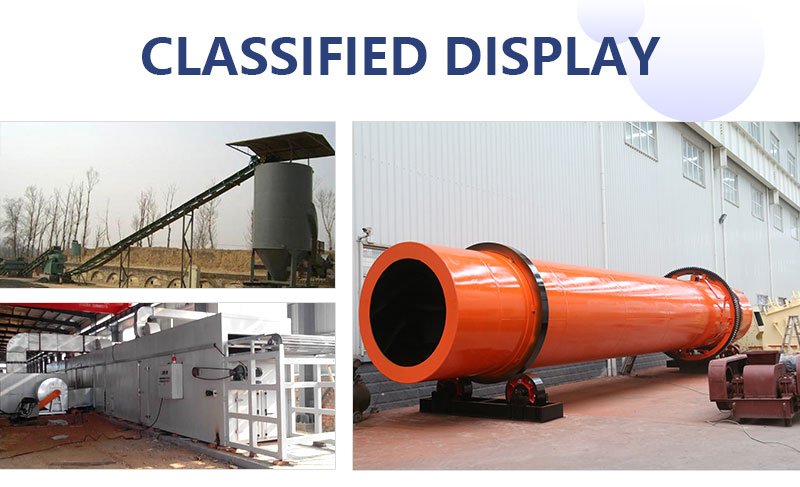
left upper: Vertical Dryer; left lower: Net Belt Dryer; right: Rotary Dryer
With the finer and finer division of industries, specialized dryers emerge as the times require. In order to meet the drying needs of different materials, the dryer can also be divided into sludge dryer, gypsum dryer, kaolin dryer, clay dryer, sand dryer, sawdust dryer, slime dryer and so on. This classification is mainly due to the different material properties. For example, materials like sludge, slime, etc. have high viscosity, high water holding capacity and large initial water content, so this series of dryer can be specially designed to prevent the material from sticking to the inner wall of the drying cylinder, which will lower the drying effect.
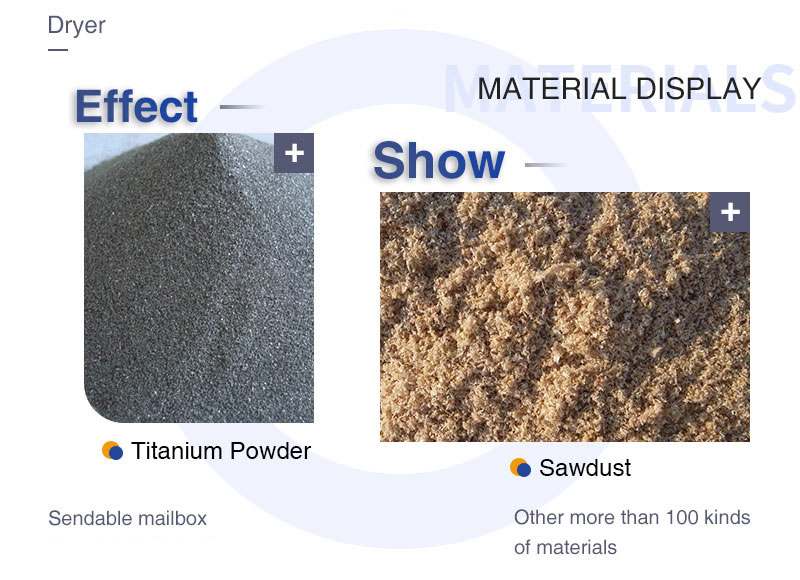
Examples of Rotary Dryer Applications
Due to the wide application, here briefly introduce rotary dryer. Rotary dryer is divided into single-drum, double-drum and three-drum rotary dryer. This is mainly based on rotary dryer structure. And according to the heat exchange modes, rotary dryer can be classified into direct heat transfer rotary dryer and indirect heat transfer rotary dryer.
As shown in figure (1), the single-cylinder dryer is mainly composed of one drying cylinder with a longer body. Most of single-cylinder dryer are more than 10 meters in length, while the structure is the simplest; the double-cylinder dryer adopts sleeve structure, which occupies a slightly smaller area than the single-cylinder dryer; the three-cylinder dryer mainly adopts three-cylinder stack structure and covers the smallest area. Accordingly, the structure is the most complex. From the point of view of maintenance cost, single-cylinder dryer is more widely used than double-cylinder and three-cylinder dryer for its lowest maintenance cost.
From the working principle, these three kinds of dryers all work based on heat exchange in the process of material movement. However, when working, there are some differences. Because of the single-cylinder structure, single-cylinder dryer machine gets the material passes through and dried at one time. When the double-cylinder dryer and the three-cylinder dryer work, the material will be circulated dried in the multi-layer from the inner wall to the out layer. According to different drying requirements, customers can choose different single-cylinder dryers of different length.
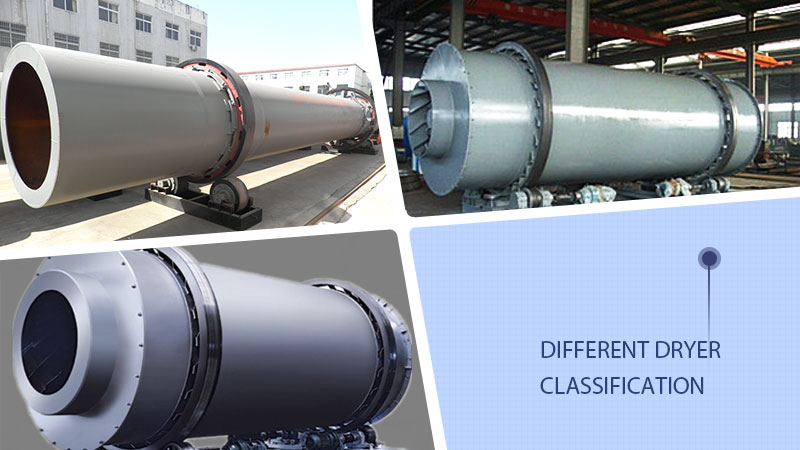
Figure (1)-left upper: Single-Cylinder Dryer; right upper: Double-Cylinder Dryer; left lower: Three-Cylinder Dryer
>>Direct Heat Transfer Type
High temperature heat gas and material get direct contact in the cylinder, by which heat is transferred to the material. This type is suitable for drying materials that are not sensitive to high temperature gas and materials that can take coal ash pollution. Slime dryer belongs to this type of drying equipment.
>>Indirect Heat Transfer Type
Hot gas heats the metal sleeve indirectly and transmits heat to materials. This kind of rotary dryer is suitable for drying powdered materials which cannot be polluted by coal ash or easy to dust. While this type of dryer has low drying efficiency.
>>Compound Heat Transfer Type
High-temperature gas is first passed through the sleeve, the hot gas is indirectly transmitted to the material through the sleeve, and then directly contact and heat transfer with the material from inside the sleeve to the outside of the sleeve. It is suitable for drying materials that are easy to catch fire and explosion, such as bituminous coal. Double-cylinder dryer and three-cylinder dryer belong to this type of dryer.
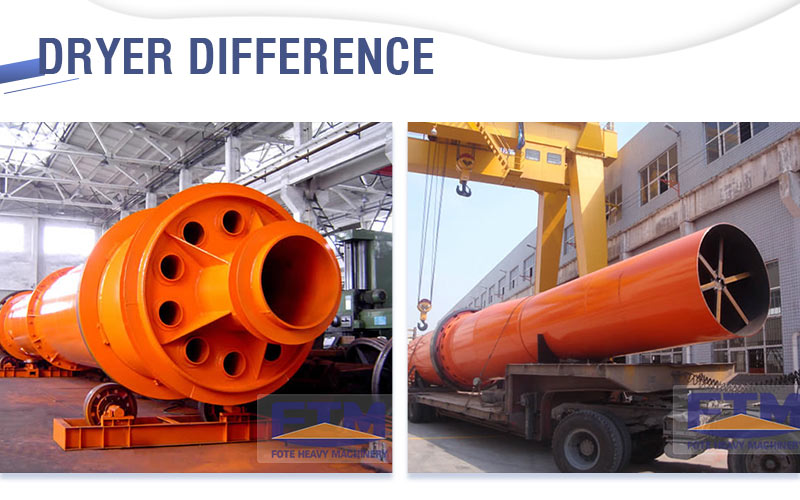
Indirect Heat Transfer Dryer and Direct Heat Transfer Dryer
From the brief introduction of the classification and characteristics of the dryer, it can be seen that the single-cylinder dryer is simple to operate because of its simple single-cylinder structure. Although the area is slightly larger than the double-cylinder dryer and the three-cylinder dryer, the maintenance is convenient and the cost is low. If it is a long-term investment, a single-cylinder dryer is an ideal choice. If taking the heat transfer mode into consideration, the direct heat transfer dryer is more suitable as long as it is not drying flammable and explosive materials. The direct heat transfer dryer can be used for more than 100 kinds of material drying, and can be invested in a variety of production lines, which can save cost.
Therefore, taking the site of sawdust dryer in Malaysia as an example, this paper briefly introduces the single tube direct heat transfer dryer. The sawdust produced by this drying line is mainly used for compression board manufacturing, which is mainly used for decoration and furniture. The initial moisture content of the sawdust dried on the spot is about 23%, and the moisture content is about 2%.
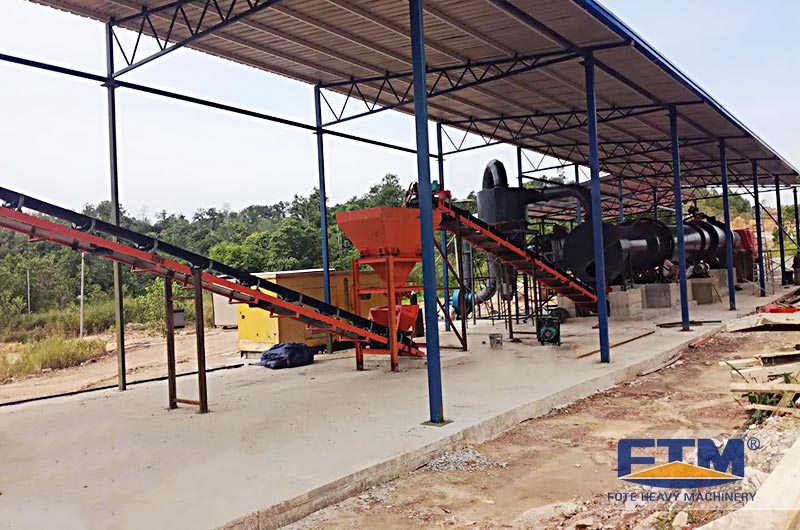
Sawdust Dryer Customer Site in Malaysia
Sawdust refers to the foam sawdust of the tree itself scattered from the tree as a result of cutting during wood processing, which can be used to develop many products that are beneficial to people's production and life. Sawdust is widely used, for example, it is the best fermentation bed cushion, cultured in the root of flowers and trees is warm quilt, after fermentation is a simple soilless cultivation material, after plastic molding is mechanical carbon semi-finished raw materials.
However, because the structure of sawdust is loose, it is easy to be wet and the water content is large. In some fields, sawdust with low water content is needed as raw material, and a single tube direct heat transfer dryer can be selected as drying equipment, which can dry materials with large initial moisture content. Sawdust dryer is a special equipment designed and manufactured for the drying of sawdust, wood powder, wood chips and so on. It has the characteristics of large drying output, remarkable energy saving effect, low maintenance and so on.
The sawdust dryer is made of a hot air stove, a feed port, a rotating cylinder, a filter tube, a material conveying pipe, a cooling tube and an outlet, the rotating cylinder is located on the active roller, the active roller is driven by the motor and deceleration drive the rotating cylinder rotates at low speed, the feed port is arranged between the heating furnace and the rotating cylinder, the rotating cylinder is provided with frying blades, and a baffle is arranged at the connection between the rotating cylinder and the filter cylinder, and a small hole is opened on the baffle, One end of the filter cylinder is connected with the rotating cylinder, the other end is connected with the material conveying pipe, the filter cylinder is provided with a block, the bottom of the filter cylinder is provided with a slag discharge hole, one end of the cooling cylinder is connected with the material conveying pipe through a blower, and the other end is connected with the material outlet.
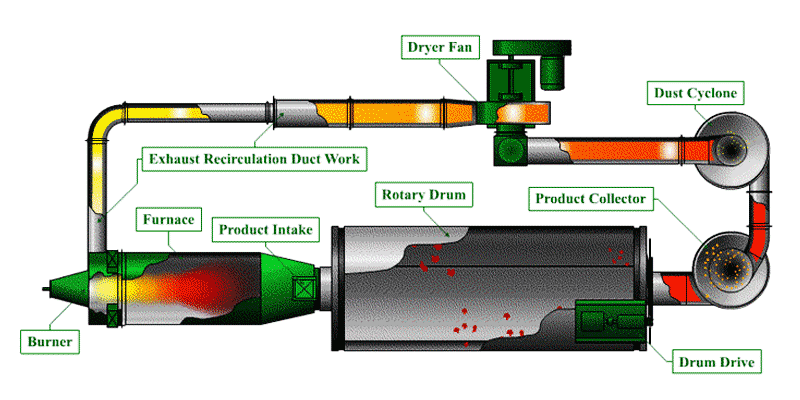
Working Principle of Sawdust Dryer
Sawdust itself has the characteristics of high humidity and high adhesion. In the drying process, the wet sawdust enters the dispersing equipment from the belt conveyor, and the sawdust, which is quickly dispersed, is divided into the following working areas after entering the negative pressure dryer.
The material feed area. Here, wet material gets contacted with high temperature wind of negative pressure and a large amount of water is rapidly evaporated. Before be stuck on the inner wall, the sawdust is lifted up by the plates and introduced into the next area.
The cleaning area. With the rotation of the rotating cylinder, the wet sawdust is lifted up and form a material curtain. It is easy for wet sawdust to be bonded on the cylinder wall when falling. At this time, the specially set cleaning device can quickly clean up the sawdust bonded to the inner wall, and simply break the lump material to enlarge the heat exchange area.
The inclined lifting area. This is a drying area with low-temperature air. The sawdust here has been in a low moisture loose state and is no longer bonded. After the heat exchange, the required water content can be basically reached.
The discharge area. There set no lifting plates in this area inside the drying cylinder. The material rolls and slips to the discharge port, and the waste heat is used to dry a small part of the material which does not meet the drying requirements, and the whole drying process is completed.
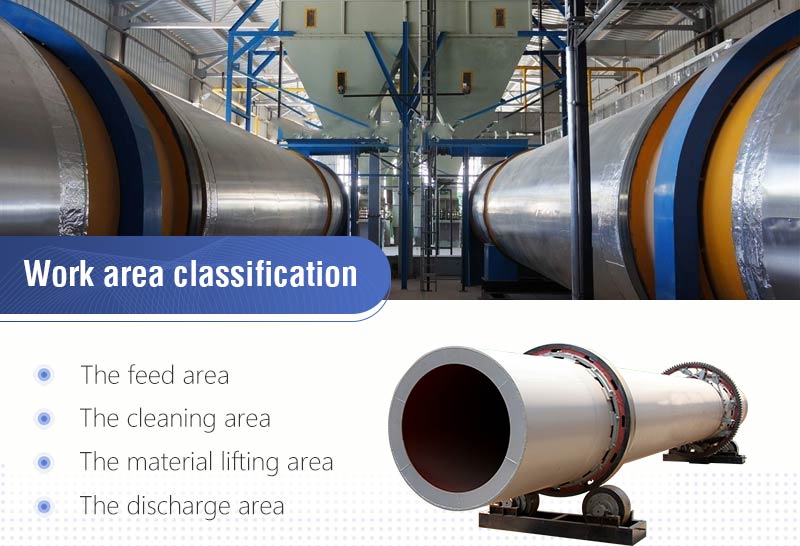
Four Working Zones inside Rotary Dryer
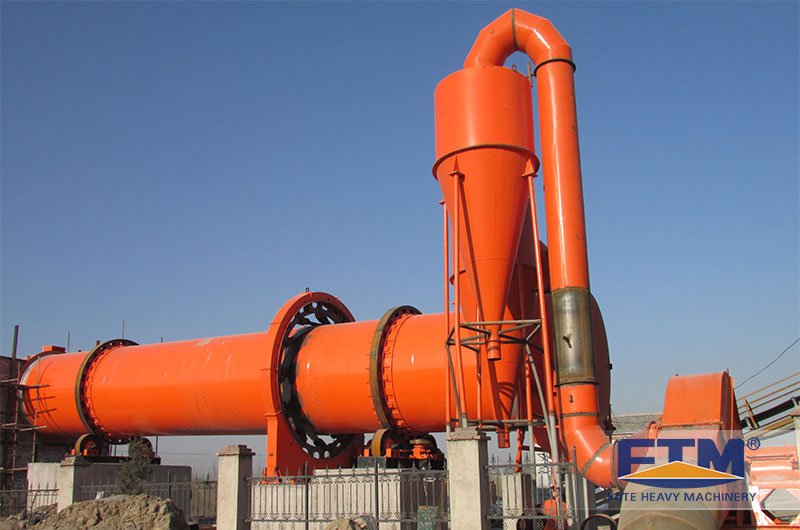
Rotary Dryer Sole Utilization
The ore dressing mainly comprises a flotation process, a magnetic separation process and the like. The single-cylinder dryer is mainly used in the flotation process and is used for drying the wet concentrate. The equipment used mainly includes a crusher, a ball mill, a flotation machine, a dryer and the like. The main process is as follows.
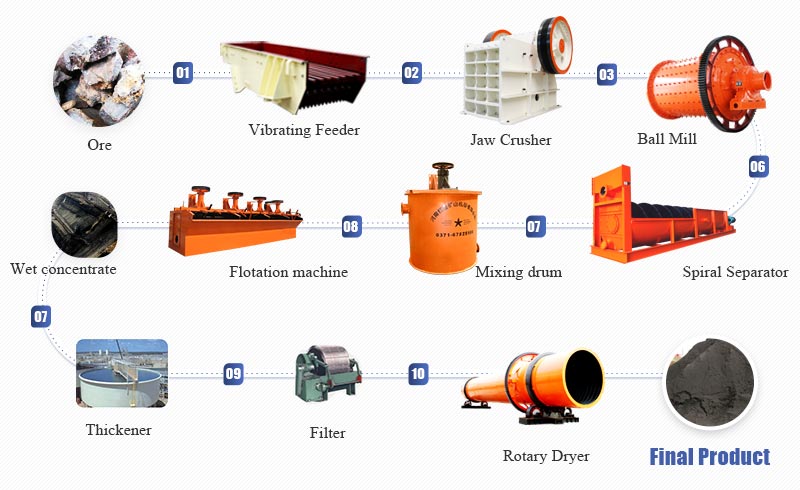
Rotary Dryer Used in Ore Dressing Plant-Flotation Process
DMC pulse dust collector: adopting pulse injection ash cleaning mode, which has the characteristics of high ash cleaning effect, proper treatment air volume, long crawler life, small maintenance workload, safe and reliable operation and so on.
Dry powder packaging machine: the packaging machine of 5-15t/h can be selected according to the output, and the bag weight error is small for a variety of production lines.
Selection on rotary dryer is based on the materials to be dried, production capacity and drying efficiency needed, etc. Customers can chat online or leave an online message to get the inquiry. Rotary dryer manufacturers can supply one or more solutions according to the requirements. You can choose one suitable solution due to the budget, drying environment and other conditions.
The rotary dryer cylinder diameter and length influence the drying strength. Generally, the length and diameter are proportional to the drying strength. Therefore, when selecting single-cylinder rotary dryer, customers can choose different diameters and length dryers based on required drying strength. For example, models like 1.2×8m-3.6×28m can be taken into consideration. Selections can also be made on the production scales. If the rotary dryer is applied in small plants, selection can be made according to the budget in the models of 1.9-7.1t/h. Different models of 6.5-26.5t/h can be selected for medium-sized plants. Large-scale plants can choose higher-production dryers, such as 42.9 t/h or 76 t/h. In general, single-cylinder dryer manufacturers provide customized services, which includes free solution consultation, dryer production line flow charts, single-cylinder dryer price, installation and operation instruction, after-sales service and so on.
| Item/Unit/Model | Φ2.5×7m | Φ2.7×7m | Φ3.0×7.0m | Φ3.2×7.0m | Φ3.6×8m |
| Diameter of outer cylinder(m) | 2.5 | 2.7 | 3.0 | 3.2 | 3.6 |
| Length of outer cylinder(m) | 7 | 7 | 7.0 | 7.0 | 8 |
| Cylinder volume( m³ ) | 16.63 | 16.63 | 52.678 | 52.678 | 81.38 |
| Rotating speed of cylinder(rpm) | 4-10 | 4-10 | 4 -10 | 4 -10 | 4 -10 |
| Initial moisture of slag(%) | 10-12 | 10-12 | 10-12 | 10-12 | 10-12 |
| Final moisture of slag(%) | 1 | 1 | 1 | 1 | 1 |
| Initial moisture of yellow ground(%) | 8-10 | 8-10 | 8-10 | 8-10 | 8-10 |
| Final moisture of yellow ground (%) | 0.5-1 | 0.5-1 | 0.5-1 | 0.5-1 | 0.5-1 |
| Highest intake air temperature(℃) | 700-750℃ | 700-750℃ | 700-750℃ | 700-750℃ | 700-750℃ |
| Production capacity(T/h) | Yellow sand25-30 Slag20-25 | Yellow sand30-35 Slag25-30 | Yellow sand35-40 Slag30-35 | Yellow sand45-50 Slag35-40 | Yellow sand65-70 Slag60-65 |
| Motor type | Y2-132m-4E | Y2-132m-4E | Y2-160m-4 | Y2-160m-4 | Y2-160m-4 |
| Motor power(kw) | 7.5×2 | 11×2 | 7.5×4 | 7.5×4 | 15×4 |
| Reducer type | XWD7-23-11W | XWD7-23-11W | XWD6-23-7.5KW | XWD6-23-7.5KW | XWD8-23-15KW |
| Velocity ratio of reducer | 29 | 29 | 29 | 29 | 29 |
Note: customized solutions can be provided for different drying requirements
 Online Chat
Online Chat